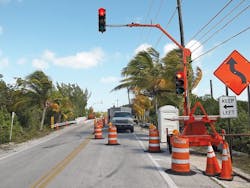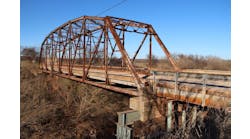The Florida Keys are renowned for colorful sunsets, world-class fishing and enduring landmarks such as the Southernmost Point in Key West.
Yet many of the islands making up the Keys are less well-known, enjoyed by a small group of residents and loyal tourists. It was on one of these more inconspicuous Keys where a bridge rehabilitation team was presented with both environmental and historical challenges, all of which were successfully met with a combination of teamwork and attention to detail.
The project was the rehabilitation of the Boca Chica Road Bridge, a 60-ft span located on Big Coppit Key, about 11 miles north of Key West. Serving as a link to Geiger Key and the Geiger Key Marina, the bridge was in need of rehabilitation due to the normal wear and tear that comes after decades in a coastal setting. The goal of the project was to extend the structure’s lifespan by another 15-20 years, while still maintaining its integrity and ability to provide safe passage over Geiger Creek.
A unique environment
Stretching approximately 115 miles from the southeastern coast of Miami to the southernmost tip of Key West, the Florida Keys are famous for their largely unexploited coastline. The island’s infrastructure needs to be unassuming, and the Florida Department of Transportation (FDOT) focuses on providing safe, reliable and inconspicuous roads and bridges to maintain the distinctive environment. That being said, it’s not always easy. In fact, construction in the Keys presents a set of circumstances not encountered in many other locations.
Undeniably, one of the foremost distinctions of working there is the heightened focus on environmental sensitivity. With the Boca Chica Road Bridge being surrounded by relatively shallow water on both sides, the team had to strictly adhere to environmental permitting. This involved taking specific precautions to protect the local marine life, including manatees, a variety of coral, mangroves and sea turtles. The tried and true approach in this situation was to simply avoid contact with these species and resources whenever possible, so the team avoided excavation and limited underwater work to instances only when it was absolutely necessary. They also worked together to ensure that the proper manatee signage was posted, and were diligent in watching for manatees and other sea life during times of potentially unsafe activity.
Equally as crucial as environmental protection, the need for limiting public disruption is heightened when working in the Keys. Those who live in these largely undeveloped islands are extremely focused on maintaining their remote, natural feel. The environment also appeals to many tourists and residents of Florida who are looking for a vacation, a predominant reason that the economy in the Keys is heavily reliant on tourism. Trying to stay out of the way on the Boca Chica Road Bridge project was not only important in maintaining this “island vibe,” but also for practical purposes, as the bridge provides the only way for travelers on Big Coppit Key to access Geiger Key. Therefore, the team knew that, whatever the approach, one of the bridge’s two lanes had to remain functional at all times.
Rehabbing lost history
The first major decision FDOT faced was whether to replace or rehabilitate the bridge. They conducted a full cost-benefit analysis, concluding that a proper rehabilitation would benefit the community in multiple ways.
First, the price tag on rehabilitation was one-third of that for replacement, a definite bonus for taxpayers. “This was a major factor in the decision,” noted Pablo Orozco, FDOT’s design project manager. “The funds saved by choosing rehabilitation allowed the department to allocate them to other projects.” Orozco also knew that with proper routine maintenance, a key part of FDOT’s Bridge Maintenance Program, the life of the existing bridge would be extended by as much as two decades, avoiding the disruption and long project duration that comes with the demolition and construction of a new bridge. Rehabilitation won out as the best option, both economically and feasibly, but would lead to a further, more significant challenge, as the team would be rehabilitating a bridge for which they had no original plans.
Built in 1957, the bridge’s original records no longer existed, leaving the team with very little to go on regarding its design, construction or history. This lack of contextualizing information turned a seemingly routine rehabilitation project into something that would require a good deal of digging into the past.
The first step was to conduct research of similar bridges built in the 1950s and 1960s. Combining this information with their collective knowledge of bridges in comparable environments, the team analyzed the types of materials, design traits and engineering techniques most likely to have been used. This allowed them to establish research-based assumptions on the bridge’s initial construction. They also made use of the sufficient amount of redundancy in the structure itself, and combined this knowledge with the historical data they had collected.
Even while faced with unexpected challenges, the pile jacket removal was completed without delay to the schedule or an increase to the budget. FDOT was pleased with the rehabilitation.
New jackets
Knowing that at least one lane had to remain open to traffic at all times, the team decided to sequence the repairs, taking advantage of the structure’s consistent, repetitive design. They did so by breaking the jackets into four sets of five to six jackets each, allowing them to sequence the work and ensure that adjacent piles were not worked on simultaneously. They also utilized temporary signals at either end of the structure, in order to be as accommodating as possible to those using the bridge to travel from one island to the other.
With traffic control in place, new pile jackets could be installed. Because they had very scant records of the bridge’s early days, designers were unable to determine if the existing jackets contained any steel. If they did contain steel, that would mean another metal would be introduced into the equation, requiring an additional connection that comes with an increased rate of failure. Since the only way to determine if the existing jackets contained any steel was to chip them down, it was determined to be more cost-effective to simply remove them and install new jackets.
Using a 15-lb pneumatic chipping hammer, a diver began the painstaking process of chipping away at the existing jackets. Time in the water was strictly limited in accordance with the project permits. The old jackets came off in pieces without complication, as most contained cracks that went to the outside of the existing pile steel-rebar cage. Fortunately, none of the concrete removal extended beyond this point, and therefore no temporary support measures were necessary to support the bridge. Additionally, the exposed steel aided the continuity corrections necessary to the existing reinforcing steel.
Once the old jackets were removed, a special type of pile jacket was installed—cathodic protection (CP) pile jackets. CP jackets were employed in order to protect the existing reinforcing bars of the piles from corrosion. Just as the jackets protect the piles from physical wear, cathodic protection is a practice which safeguards the existing pile rebar from chemical wear and corrosion through the introduction of a “sacrificial” metal to the structure. This “decoy” metal then becomes the bearer of the electrochemical reaction that causes corrosion. By displacing the reaction, the newly introduced metal takes on the corrosion, protecting the structural component of the bridge. In this case, zinc mesh was pre-installed on the inner face of a permanent 1/8-in.-thick fiberglass form, which, along with the reinforcing steel, was tied to a bulk zinc anode affixed to the base of the pile near the ground line. These zinc components are what was used as the sacrificial metal, and will corrode before the jacket and pile rebar. Lastly, a junction box was mounted to the bent cap near the top of the jacket and the system energized by a CP specialist.
The Boca Chica Road bridge is skirted on both sides by shallow waters that are home or passageway to a large number of marine species.
Completing the rehab
The pile jacket removal and installation was the most intense part of the project, but it wasn’t all the team was responsible for. Additional work on the remote bridge included inspection of a partial deck replacement at the approach slab, as well as on numerous locations on the bridge’s cantilever “walkway.” This work was done by first testing the deck for concrete quality to determine the areas that needed replacing. Each section in need of replacement was chipped off down to the rebar, as well as underneath the rebar, using light chipping hammers, followed by the pouring of new, 11,000-psi concrete. On average, the areas that were replaced received approximately 4-5 in. of new concrete. After the partial deck replacement was complete, methacrylate sealer was applied to the entire bridge deck.
Lastly, the team inspected the repair of spalls located primarily on the beams, as well as multiple slab cracks using the crack-injection method. This required the injection of an epoxy into each crack, with a total of 700 linear ft of epoxy being used.
Teamwork = success
Even while faced with unexpected challenges, the pile jacket removal was completed without delay to the schedule or an increase to the budget. In fact, the teamwork-centered approach remained as the predominant theme throughout construction, and the rehabilitation was finished an entire month early. RS&H CEI Project Manager Jacki Hart noted that this was due to “each individual team member contributing to the group and taking responsibility for the overall outcome.”
FDOT also was pleased with the rehabilitation. Engineer of Record Bob Forand of BCC Engineering made note that the Boca Chica Road Bridge Rehabilitation “provides an example of never underestimating the power of consultant partnering.” He also noted the important role played by the CEI team on the project, as they “know how to communicate, bring decision-makers together and maintain urgency.”
Most importantly, FDOT started and ended the project without a word of discontent from the public, who can now enjoy two more decades of uninterrupted travel on the Boca Chica Road Bridge.



